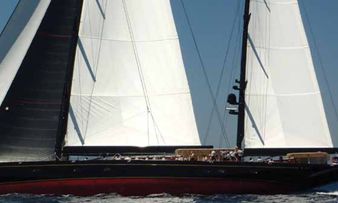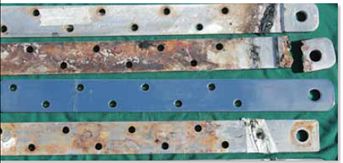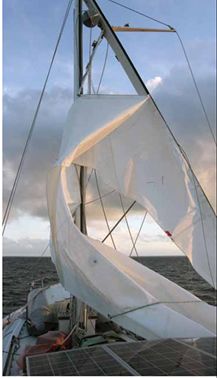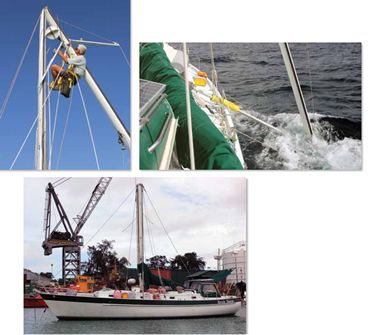Through the commotion of a 30-knot squall, I heard the chainplate pop. It was not an unusually loud pop. The result was impressive, nonetheless. What once was, just a few moments earlier, the tallest part of the mast on our Valiant 40 Brick House was now the lowest, scraping the tops of waves in the middle of the South Pacific Ocean. The dispirited look on my wife Rebecca’s face made the terrible situation even more depressing. I swore, in rebuilding our rig, we would never again be the victim of the weaknesses stainless steel can hide. We would replace our chain plates, toggle pins, and mast tangs with titanium.
In name alone, the word titanium evokes images of superhuman strength. The metal is aptly named after the Titans, the race of powerful Greek gods, descendants from Gaia and Uranus.

Titanium is whitish in color and the fourth most abundant metallic element in the Earth’s crust. Ninety-five percent of mined titanium becomes titanium dioxide. Titanium dioxide is the white pigment added to all types of paints. Titanium dioxide makes paper bright white and is the white paste that some sailors like to smear on their nose on a sunny day to provide a physical barrier against UV radiation. Our white homes and sailboats are resplendent in white titanium.
The remaining 5 percent of mined titanium is used to make metal components that must be light, strong, and resistant to heat and corrosion. This five percent, though small, represents a rapidly growing market.

Landing gear of large commercial aircraft, like the 747 and 777, are made of titanium. No other metal has the resiliency to repetitive shock loading and offers the weight savings of titanium. Nearly 80 percent of the structure of the Lockheed SR 71 reconnaissance plane, the highest flying, fastest plane ever built, is made of titanium. From drill bits to eyeglass frames to tennis rackets to artificial heart valves, titanium metal is in our lives every day.
Of particular interest to sailors is titanium’s resistance to galvanic corrosion. Only silver, gold, and graphite are more noble than titanium. For titanium to be even slightly affected by sea water, the water must first be heated to over 230 degrees. Cryogenic temperatures will not affect the performance of titanium. It has the highest strength-to-weight ratio of any metal and is non-magnetic. Titanium is up to 20 times more scratch resistant than stainless steels.
The more one considers the physical characteristics of titanium, and how perfectly suited it seems for marine applications, the more one might wonder why we don’t see more of it in our boats. Part of the problem is the relative cost of titanium alloys, but a second factor is probably more to blame for titanium’s scarcity in the marine market. Titanium fabrication is a highly specialized field that requires specialized equipment. You can’t just hire your local welder to go out and build you a titanium arch.
Marine-grade Titanium
The performance characteristics of titanium will change greatly with its alloying of other metals for customized work. Commercially pure titanium is typically rated from Grade 1 to Grade 4, with each higher grade corresponding to increasing strength levels. Some of these grades are used to withstand boiling acids; some are used for heat and corrosion-resistant applications such as heat exchangers and chemical processing tanks.
The marine industry standard is Grade 5, Ti-6Al-4V. This alloy is 90 percent titanium, 6 percent aluminum, and 4 percent vanadium. The alloy is so widely used that it represents 75 percent of all titanium alloys produced. Grade 5 has a yield strength over 3½ times greater than 316 stainless steel, yet weighs only 56 percent as much. Yield strength, sometimes called engineering strength, is the amount of pressure or force a material can take before changing shape without returning to its original shape. But titanium is also nearly twice as resilient as steel, so it will flex and return to its original shape under the same loads that might permanently bend a comparable piece of stainless.
Not only is titanium strong, it is highly resistant to chemicals. Being a reactive metal, it spontaneously forms an oxide film whenever there is any amount of water or air in the environment. That oxide film eliminates the possibility of crevice corrosion or stress-corrosion cracking. Titanium is immune to galvanic corrosion when immersed in seawater, but like stainless steel, titanium may encourage electrolysis of a less noble metal it is in contact with. Profurl roller-furling uses titanium screws that pass through the aluminum body of their housings to minimize galvanic corrosion. Still, an isolator like LanoCote (www.lanocote.com) or Tef-Gel (www.tefgel.com) needs to be applied to the threads of the titanium screws, the same as one would do if stainless-steel screws were used. Above the waterline, Titanium in contact with 316 stainless is of no greater concern than where stainless-steel threaded studs screw into bronze turnbuckles.

Working sheets of titanium into yacht parts requires the same tools that are used for forming stainless steel. Drilling requires sharp cobalt drill bits turning at similar speeds used for stainless steel and plenty of lubricant (olive oil works) for cooling. Sawing and grinding also require sharp tools with good chip removal. Cutting with waterjet and laser is the most effective. But shears that slice through thick 316 stainless steel will stop when forced against equally thick plates of titanium.
When bending titanium, the bend area must first be heated to around 800 degrees, as the yield strength drops to about 40 percent at that temperature. If titanium is overheated to the point where it glows, it can react with air and become oxygen embrittled. For this same reason, cutting titanium with oxyacetylene flame is not recommended.
Welding titanium is not for the inexperienced. Air will contaminate the weld causing discoloration and brittleness. An inert gas like 99.99 percent pure argon must shield the area on both sides of the weld till the material cools below 800 degrees.
The physical properties of titanium are exactly those that are needed in sailboat rigging as it pounds through ocean waves. Unlike stainless steel, titanium will not deteriorate, or crack, or rust, or have an unexpected catastrophic failure. Once installed on a sailboat with titanium fasteners, a properly sized titanium chainplate will never need polishing, although welds should be checked.
So why has the leisure marine industry been slow to use titanium?

For years, the high cost of titanium made it an aerospace metal for government projects and commercial airplane parts where there was no alternative metal to use. That high cost was an unforeseen result of the protectionist Berry Amendment. The 1941 legislation made it mandatory for the U.S. government to purchase only 100 percent U.S. manufactured goods intended for military use. Titanium was soon added to the list of specialty metals covered under the Berry Amendment. This gave the few largest U.S. titanium makers a lock on the world’s largest titanium customer, the U.S. military. This eliminated competition and kept the price of titanium flying high.
This grip on the U.S. titanium market also eliminated any need to streamline the smelting process. But when the U.S. military shifted from a strategic bomber defense to a missile defense, the use of expensive titanium plummeted and some U.S. producers went out of business. The few that remained could only survive by keeping the price of titanium high for their government customers.
As world production and use in the leisure marine market increases, the price of titanium should continue to fall. One day, titanium will replace stainless steels. The savings to insurance companies that will no longer have to pay for expensive boat losses and the increased safety to sailors will be enormous.
Practical Matters
The problem for an individual boat owner is that the local welding shops do not carry a stock of titanium sheets and to order small lots and fabricate a few parts can be time consuming and ultimately not the price one would hope to pay. There are large outlets for titanium fabrication that solve the problem. A company such as Allied Titanium has fabricating outlets in Europe, U.S., and China. A boat owner can log onto the Allied website to view thousands of items such as nuts, bolts, and chainplates. If a particular boat part is not listed, it can be fabricated.
We needed 10 new chainplates, all of the same design, and a combination bow roller/chainplate assembly. Since there had been no previous purchase for these items for a Valiant 40, we had options on how to enter the information into the Allied database.
First we logged in and became a customer, creating a user name, and password. We could trace the chainplate outline and bolthole placement onto stiff paper, noting the thickness of the original plate and the desired finish such as sandblasted or polished. However, we thought sending an actual chainplate would be better. Allied then hand-drafted our chainplate into its 3D system. We could watch online as the chainplate was received at Allied and made its way through the design process. If a customer supplies design in a 3D CAD file in SolidWorks, Rhino, or 3D Auto CAD, there is no drafting charge at all. If the customer supplies a two-dimensional drawing that is properly dimensioned, with tolerances, finish, etc. and they allow Allied to add their part to the Unique Product Database (UPD), then there is no charge for conversion to a SolidWorks 3D CAD file.
At Allied, the part name, tolerances, finish, titanium grade, etc., are entered into the UPD, creating both an item number and a temporary UPD number. The customer then approves the drawings. When the design process is completed and the customer approves the price, the part design is then transmitted to one of Allied Titanium’s factories, some of which are in China.
Many boat owners don’t like the idea of having anything made in China, yet much of the gear we rely on is already made there. Japan produced a lot of junk after World War II, but then learned to do it right and has equaled or outdistanced America in many manufacturing fields. So too, China is refining the quality of its products.
As Practical Sailor pointed out in the August 2011 look at mainsails, sails made in China are often rebranded and sold by the top sailmakers in America. Nearly all stainless-steel wire rigging used on yachts now comes from China or Taiwan. When it comes to Chinese titanium, that metal has been strategic in the past, requiring strict quality control by the Chinese military. This means that Chinese factories and workers know how to make titanium products properly. The Chinese are now cashing in on the world demand for titanium.
According to Allied, “Each time titanium is smelted, re-smelted, or milled, it must have mechanical and chemical tests done on the lot. When a customer requests a ‘certs,’ the results from the last certification is provided. In most cases, this is the mill certification.” However, some U.S. customers of Allied send a sample of their purchase to an independent lab for backup testing. “In all cases, our 6-4 titanium parts have tested above 128,000 psi yield strength. If a customer has an issue with a certain country, we can manufacture their parts in another country (at a different price, of course),” Greimes said.
When the part is complete, it is sent directly from the manufacturing plant to the Allied Titanium Quality Assurance Department in the United States via Fedex, UPS, or DHL. After passing quality assurance, it is shipped directly to the customer.
The street price for one of our chainplates was $260 at the time of this writing (2011). We saved considerably by negotiating a price for all 10 to be made at the same time. From the day we mailed our old chainplate to Allied Titanium to the day 10 titanium chainplates arrived in our hands, took 65 days.
We installed all new chainplates, bolts and nuts, clevis pins, mast tangs, and bow roller assembly made of titanium. One immediate problem was the brilliant shine of the chainplates sticking up from the deck. They suddenly made the paint job on our boat look terrible. A sandblasted finish for the chainplates is available, and this might be a good option for the owner of an older boat.
Over the past 6 years, the money we have not paid to insurance companies has been reinvested in continually upgrading electronics and safety equipment on our floating home.
A new rig with a foundation in titanium will certainly keep us safer and stronger than ever before. I only wish we were wiser and made the titanium upgrades before our rig came down.






































It seems that strength is not the issue, rather corrosion resistance. We used Silicon Bronze for chainplates on our Valiant 40 Ruby, launched in 1980, and after 40 years they show no signs of any sort of corrosion. In the Mcmaster Carr catalog, 1/4″ X 3″ grade 5 plate in Titanium is currently at $190 a foot, which would be higher than you would pay from a fabricator. I could not find a price for Silicon Bronze (we used Everdur) on line, but high strength brasses and other bronzes are 1/4 the 1/2 the cost, and easier to fabricate and weld.
Silicon bronze is an excellent choice and a favorite of contributing editor Ralph Naranjo. It is, as you say, getting harder to find. Here is a relevant article he wrote on the topic.
https://www.practical-sailor.com/boat-maintenance/marine-metal-warning
Right. The whole sailing industry should return to bronze for most equipment. But don’t use brass except for decorative and non-load bearing parts.
While it is nice that Darrell updated an older piece by Patrick Childress, for PS not to give any credit above the byline to Patrick who just recently died of Covid-19 in Cape Town is horrible – especially as Patrick was a very regular contributor to PS. Come on folks, we expect much better than this of you. His widow, Rebecca is still sailing Brickhouse on that new rigging and they just completed the same trip that caused them to lose their rigging the last time just before he died.
Thank you Steve for pointing out that it was Patrick who wrote most of that article. He was the one who made me aware of the possibility of replacing my chain plates with Titanium just after he replaced his own. We lost a true friend and knowledgeable cruiser when he died. Rebecca is determined to continue the life style they both loved so passionately.
Darrell reached out to me personally and explained that I guess when Patrick passed, all of the bylines migrated to him by default. They are working to fix this. I appreciate that this was done in error and by no means was meant to disrespect the great memory and contributions of Patrick. I appreciate the personal touch and would like to retract my criticism of PS for it’s treatment of Patrick.
I apologize for the confusion. The editor “bio” at the bottom of the page is a new feature, and it doesn’t mean I am the author of the piece. We are still trying to update the articles that had no author listed — which is to say 90 percent of our reports, because they are multiple parties involved in most tests. I’ll go in and update this and Patrick’s other stories ASAP. His loss was heartbreaking.
“President Barack Obama is allowing an unsigned repeal of titanium from that list to collect dust on his desk.” How much of this article has been “updated” since it was written 9 years ago, in 2011? Since the above is still in it, obviously not everything.
I updated it with Patrick’s name, took the politics out. The rest is 2011. We have hundreds of reports that are still helpful to sailors going back 20 years, staff is working hard to keep them updated. Readers should confirm all prices listed, since those generally do not get updated.
I recently had a cranse iron and bobstay chainplate made by allied titanium. The overall workmanship was absolutely horrible, the welds looked like they were done by someone welding for the first time, the tabs for the pins were offset instead of perpendicular to each other, there were spots with grinder marks and welds that burnt through. I have no idea how these parts would have made it out of any shop. I would certainly not recommend them to anyone.